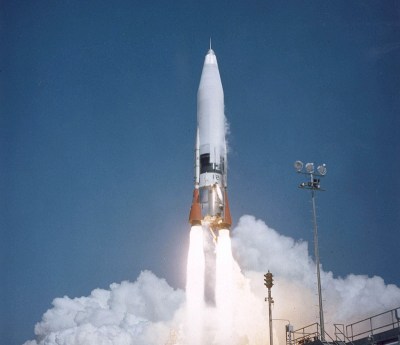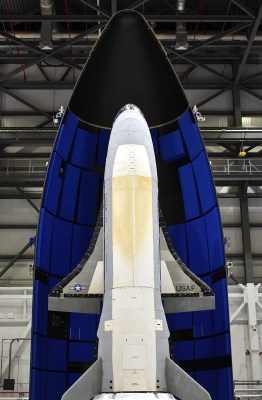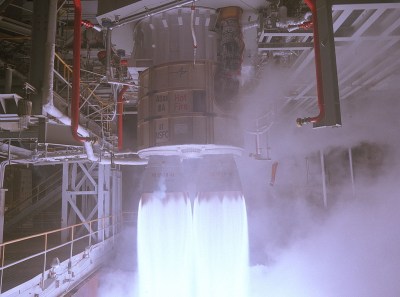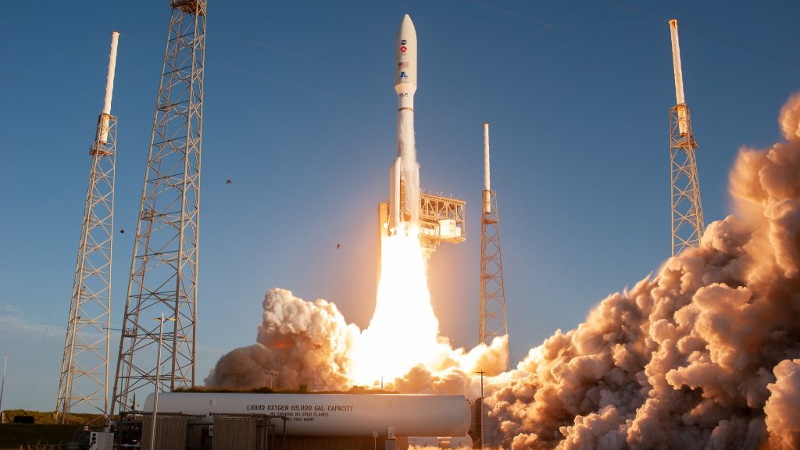The Atlas family of rockets have been a mainstay of America’s space program since the dawn of the Space Age, when unused SM-65 Atlas intercontinental ballistic missiles (ICBMs) were refurbished and assigned more peaceful pursuits. Rather than lobbing thermonuclear warheads towards the Soviets, these former weapons of war carried the first American astronauts into orbit, helped build the satellite constellations that our modern way of life depends on, and expanded our knowledge of the solar system and beyond.

Naturally, the Atlas V that’s flying today looks nothing like the squat stainless steel rocket that carried John Glenn to orbit in 1962. Aerospace technology has evolved by leaps and bounds over the last 60 years, but by carrying over the lessons learned from each generation, the modern Atlas has become one of the most reliable orbital boosters ever flown. Since its introduction in 2002, the Atlas V has maintained an impeccable 100% success rate over 85 missions.
But as they say, all good things must come to an end. After more than 600 launches, United Launch Alliance (ULA) has announced that the final mission to fly on an Atlas has been booked. Between now and the end of the decade, ULA will fly 28 more missions on this legendary booster. By the time the last one leaves the pad the company plans to have fully transitioned to their new Vulcan booster, with the first flights of this next-generation vehicle currently scheduled for 2022.
An Impressive Dance Card
Over the years, the Atlas V has lofted some particularly notable payloads. It sent the Mars Reconnaissance Orbiter on the path towards the Red Planet in 2005, and provided the initial kick that sent New Horizons on its decade-long trip to Pluto a year later. It launched the OSIRIS-REx mission in 2016, which resulted in the first NASA vehicle to successfully collect a surface sample from an asteroid.

The venerable booster has also carried the autonomous X-37B spaceplane into orbit on all but one of its missions, which do double duty as both shadowy military affairs and opportunities to perform commercial scientific research. In 2019 the Atlas V even demonstrated its crewed aspirations by carrying the first Boeing Starliner into orbit, and although the spacecraft itself failed to achieve its mission goals, the rocket performed flawlessly. Finally, it had the honor of carrying both the Curiosity and Perseverance Mars rovers.
While you could argue that most of the Atlas V’s future flights won’t have quite the historic gravitas as its previous missions, there’s certainly some very important launches in the pipeline. For example, the booster is currently manifested to carry no less than five Boeing Starliner capsules to the International Space Station by the end of 2023, with most of them being operational crew missions.
In 2022 it’s slated to launch an exciting NASA project to demonstrate reentering the atmosphere with an inflatable heat shield, and in October of this year it will launch the agency’s Lucy spacecraft that’s designed to study six so-called “Trojan” asteroids that share an orbit with Jupiter over a twelve year period.
There’s also a whole slew of communication and Earth-observation satellites it’s scheduled to carry into orbit, including at least one that’s currently classified by the National Reconnaissance Office. Amazon has also contracted nine Atlas V launches from ULA to help build out their Project Kuiper satellite constellation, which will eventually consist of thousands of satellites, and is designed to compete with Starlink from SpaceX.
A Change in the Wind
With a perfect safety record, a long list of historic accomplishments, and plenty of customers still eager to put their payload onboard, why sunset the Atlas V? The most obvious reason is cost, as the expendable booster simply can’t compete with the new generation of vehicles from commercial launch providers like SpaceX. ULA has reduced their prices in an effort to stay relevant, but a flight on the expendable rocket still costs at least $100 million. The reusable Falcon 9 on the other hand, can put nearly as much payload into the same orbit for roughly half the price.

But the price tag is only part of the problem. After all, customers like NASA are far more concerned with making sure the mission goes off without a hitch than they are in saving a few million dollars. The final nail in the Atlas V’s coffin has nothing to do with how much money it takes to put a payload into orbit, but everything to do with the engines the rocket uses to do it.
Since the introduction of the Atlas III in 2000, the Atlas family of rockets have been powered by the RD-180. This extremely efficient staged combustion engine burns liquid oxygen and kerosene, and in many respects, is considered one of the finest rocket engines ever flown. Unfortunately, it’s also made in Russia.
Politically, this is simply no longer sustainable. At various points in time Russia has threatened to stop shipping the engines to the United States, and for its part, the US Congress has imposed limitations on how many RD-180s can be imported. In 2016, partly in response to the Russian annexation of Crimea, a bipartisan agreement banned the use of Russian-made rocket engines for any national security missions beyond 2022.
Vulcan to the Rescue
Facing the loss of the extremely lucrative national security flights in 2022, United Launch Alliance had to come up with a solution. The company had considered swapping out the Russian RD-180s for a domestically produced engine, but in the end, it made more sense to create a whole new vehicle that would be more price competitive against newer rockets like the Falcon 9.
Vulcan’s BE-4 engines are being built by Blue Origin, and the relatively comparable temperatures of its liquid oxygen and liquid methane propellants has allowed the use of lighter orthogrid tanks and reduced bulkhead insulation, improving the overall mass ratio of the fuselage. While the first stage of Vulcan is projected to be only a few meters taller than that of the Atlas V, the fact that it’s considerably wider at 5.4 m (18 ft) compared to its predecessor’s diameter of 3.81 m (12.5 ft) means that the newer rocket to carry approximately 50% more propellant.
Like the Atlas V, the Vulcan supports optional solid rocket boosters (SRBs) that are attached radially around the first stage. The Vulcan will use larger versions of the GEM-63 SRBs currently flying on the Atlas V, mounted in symmetrical pairs; a departure from the unique asymmetrical booster arrangement used previously. The Vulcan will also include an upgraded version of the Atlas V’s Centaur upper stage, which ULA’s CEO Tony Bruno says will be more than twice as powerful as the current configuration.
Unfortunately, Vulcan missed the planned July 2021 date for its first launch. Construction of the vehicle itself and its associated ground support equipment has progressed well, with a prototype booster rolled out to the launch pad in August for fit and tanking tests, but flight-ready engines have yet to be delivered by Blue Origin. With the development of Vulcan’s main engine now four years behind schedule, and the 2022 cutoff date for the RD-180 fast approaching, United Launch Alliance may soon find itself even farther behind its New Space rivals.
















Wonder who the new customers are going to be for the RD-180 once the US stops buying? Maybe China with their space ambitions.
They’ll buy a half dozen, reverse engineering them and build their own inferior copies. (See China and jet engines.)
Seems fair enough; that was how the USSR used to operate, after all.
That kind of dismissal will leave us in the dust. China’s space program is progressing rapidly and they have the political will to make goals and stick with them. The notion that all china does is make copies is tired, and frankly a bit racist. I’ve met many a Chinese scientist and they are smart and work very, very hard.
Unfortunately, the system of “democratic centralism” as is applied in communist countries like China doesn’t support such progress. It fosters conformity and corruption.
The problem is that the system is designed to make “shit float up”, but it achieves the opposite. Embarrassing your superiors by criticizing their errors is considered sabotage, and even if an error is clearly made, someone else lower down must be at fault at all times. This effectively kills taking any initiative or personal responsibility. I’ve found dealing with Chinese researchers in academia, if something is written in a book by a venerable professor, then it’s gospel. You read the book and do what it says. If it doesn’t work, you “adjust” until the results agree with the book.
Exactly, it’s the system not the people, look at Taiwan and Hong Kong, without the stifling communist system the Chinese do great things, not everyone and everything is racist.
Wouldn’t be suprised if Kim Jung got a couple, well , just because
Forgive me but for us non-rocket scientists…
There appears to have been so much change over the years. Is there a fundamental part that has remained the same from the early years until now that fundamentally makes an Atlas an Atlas? Is this more of a rocket that is being retired or a brand name?
I was wondering the same thing. The Wikipedia page makes it seem like it has been gradually evolving for the last 60 years, rather than having a specific point where it became a fundamentally different rocket. I think for that reason it makes sense that modern Atlas rockets are still part of the Atlas family.
Perhaps someone with more knowledge on the matter could chime in.
“makes it seem like it has been gradually evolving for the last 60 years”
Sort of like Soyuz?
The Centaur balloon tank is heritage Atlas tank design. The Atlas V booster is more a Titan IV heritage tank. It is pressure stable, meaning if you vent the tank to ambient it won’t collapse without support. The LO2 and RP1 tanks on Atlas V are “spliced” or bolted together. All heritage Atlas I, II & III boosters were contiguous across LO2 and RP1 with just an intermediate bulkhead in-between. The Atlas V booster started life in the same factory as the Titan IV was built just with the RD-180 from the Atlas 3.
Atlas 3 was a big departure from Atlas 2 and 1 eliminating the stage and a half behavior. Atlas 3 and V held the entire engine system through all of boost phase.
It’s something of a Rocket of Theseus. Each new version kept some parts of the previous version, but no part from the first generation has been kept through to the Atlas V.
The Centaur upper stage is probably the part with the longest history, having first flown on some of the early ICBM-derived variants. It’s had a lot of its own upgrades, but the basics of stainless steel balloon tanks and RL10-family engines have stuck. And there were plenty of Atlases that didn’t have Centaurs.
its the name! Russian engines didn’t get USA into space! Barrack Obama and his ilk caused our dependence on Russia to reach ISS. The lot of them are dancing in circles to avoid the obvious. Falcon Heavy is the future.
hold on.. This started out by using refurbished SM-65 ICBM’s right.. Surely these were not using the russian RD-190 engines ? I figured the refurbished the payload section to fit the new needs.
Yah, they built parts of ours, we build parts of theirs. It’s all part of how mutual assured destruction worked. Nobody wanted to go to war with missiles built by the enemy. Genius huh?!?
Atlas started using the Russian engines around the year 2000. Before that is was American ICBM engines. US should never be outsourcing technology like that. One of the points of NASA is to help us maintain capabilities in space. ULAs mission is to get the cheapest pound to orbit rate possible. Different priorities here.
The RD-180 being adopted on Atlaswas before ULA was form via a merger.
Cost was not the only issue it also was partly to keep out of work Russians rocket scientists from giving technology to any country willing to pay them.
Sorry to ask, but how did US outsource any technology? RD180 was developed and built in Russia and to my understanding none of the parts that go into Russian rockets are built or developed in USA.Dependent on foreign manufacturers on lesser degree, yes; outsourced – absolutely no.
From what I can read here the only reason why Atlas is being retired is because it uses RD-180 and it does not have a suitable local replacement and instead of developing a engine for Atlas the government decided that it would be wiser to develop a whole new rocket with a new engine just to not carry over a legacy design. To summarize, Atlas would have been retired long ago if it were not for the Russians and there would have been a decade gap after the retirement and the time SpaceX hit the market.
I have to question the term FLY when it comes to rockets. One flies an airplane but a rocket, you light a massive fire under it and hope for the best!
Not really. Rockets are a propulsion method. The X15 and the Space Shuttle were both powered by rockets and both were undeniably aircraft. Even rockets like Atlas, Saturn, and Falcon 9 all have guidance and control systems.
Maybe the term FLY is being used in a different way, such as “pretty fly for a white guy” as in that respect they are also fly.
On that note: I hate when historical or fantasy dramas use the word FIRE to mean RELEASE an arrow. Arrows can certainly be fired, but you should loose the arrow before you burn your fingers.
No you don’t “hope for the best” as all rockets have guidance systems, so they do know where they are going
Tory Bruno about now: “WHERE ARE MY ENGINES, JEFF?”
Lol. Be-4s will not make the 22 deadline. Tony’s retrofitting for Raptors. He’s done with DR. Evil of BO. I detail all this on YouTube Hillphantom. BO screwed ULA…lol
They could use the AR-1 if needed and keep Atlas in production though if the line has been switched over easiest stop gap might be to keep Delta alive until the Be-4 is ready since Vulcan first stage is made using Delta tooling.
Another buy Antares first stages from NG or the entire Omega rocket.
Look what happened when they phased out the shuttle, the Atlas is the American Soyuz, they should keep it in their quiver, and why can’t they build the engines they used before 2000?
The same reason it doesn’t make sense to put the engine from a Model A into a 1972 Mustang.
They could but it would not be worth while as the tooling would need to be recreated.
I’m surprised they did not look at a the F-1B which is the Apollo era F1 produced using modern tooling.
A single one of them would have more thrust than the entire Falcon 9 first stage.
Another option would be the TR-107 from Northrop Grumman one of Tom Muller’s designs before he joined Spacex as it’s the same thrust as two BE-4s.
Too bad Tory can’t get his engines. Looking at you Jeff who. I bet Tory is fully regretting his decision to go with the be-4 over the Aerojet AR-1. I wouldn’t be surprised if BO goes under soon and takes ULA with them.
All these comments and not a link to this?
https://m.youtube.com/watch?v=9jK-NcRmVcw
One of my favorite rhymes ever: “We’re leaving for Venus…. maybe they’ve seen us.”
Pure poetry. Brings a tear to my eye every time.